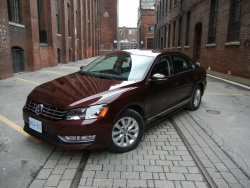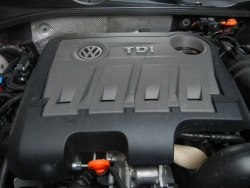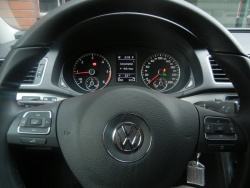 2012 Volkswagen Passat Trendline+ TDI. Click image to enlarge |
| More Volkswagen Passat reviews on Autos.ca
Manufacturer’s web site |
Review and photos by Jonathan Yarkony
Photo Gallery:
2012 Volkswagen Passat
Going into my week with the 2012 Volkswagen Passat TDI, I had two burning questions: what kind of fuel consumption would I get in this thrifty diesel (and in mid-winter no less)? And, does it really deliver the kind of driving experience, quality and value that earned it Motor Trend’s Car of the Year title?
The short answers: yes and yes; or, more accurately, 6.6 L/100 km and yes.
Surprisingly, the question that I find easier to answer is its worthiness of the Motor Trend (MT) crown. While I didn’t drive the whole Passat range as that magazine’s writers surely must have, my time in the TDI model demonstrated the value, economy and agility that helped it earn the MT prize. With a starting price of $23,975 for the base 2.5-litre model, and $27,475 for one with VW’s 2.0-litre four-cylinder TDI Clean Diesel (requiring at least the Trendline+ trim), all the way up to the $37,475 3.6-litre V6 Highline model with the six-speed automatic Direct Shift Gearbox (DSG), the Passat offers an affordable large sedan experience if you climb the price ladder. It should be noted that the Passat will only be sold in sedan body style here in North America.
 2012 Volkswagen Passat Trendline+ TDI. Click image to enlarge |
We drove the most basic TDI model available, a Trendline+ model, but with the DSG upgrade ($1,400) for an as-tested price of $28,875. While the vehicle was fairly plain, the value was still in evidence, primarily in delivering the impressive engineering of the powerplant, chassis and suspension. The interior, though plain, still features much of the quality materials that we have come to expect from Volkswagen, though with some compromises. Surprisingly, comparing it feature-for-feature with an equivalent Hyundai Sonata Hybrid left me impressed by the Passat’s value proposition.
But first, the engine: while I have waxed euphoric about VW’s high-revving, sporty gasoline 2.0-litre turbo motor (love it!), and though the TDI will not soon supplant it in my heart, my appreciation for the 2.0 TDI is much more cerebral, as is the driving experience in a vehicle so-equipped. Going into the week with this car, I prepared myself with my fuel efficiency shoes (the ones without the lead-lined soles) to help me govern my acceleration and speed and achieve full potential from an efficiency perspective. Official Transport Canada ratings are 6.9 L/100 km city and 4.9 L/100 km highway, and I achieved my 6.6 with mostly highway driving a week away from the office (no rush-hour traffic) with temperatures mostly at or below zero degrees Celsius, so, cold, but not paralyzing.
Horsepower is a modest 140, but as with most diesels, torque is generous, at 236 lb.-ft., and both are sufficient to get this car moving, but without thrills or any excitement. I rarely applied throttle aggressively, but on the few occasions that I did, especially when needing a bit of giddy-up on the highway, the transmission dropped gears and got to the heart of the torque band (between 1,750 and 2,500 rpm) and the car sedately put on speed.
 2012 Volkswagen Passat Trendline+ TDI. Click image to enlarge |
Speaking of speed, I had a big assist from the Passat in helping me keep my speeds down. In case you didn’t know, all speedometers are set to read higher than actual road speed, but there were times when I was moving with the flow of traffic and was shocked to see 140 km/h (or more) on the speedo. Whoa! Was everyone really driving that fast? Awesome! (Though, in reality, such speeds are not uncommon on Ontario’s Highway 401 in the Toronto area. -Ed) But really, what’s going on? Oh, I know, there’s a Civic with its very public digital speedometer. Handy, that, so I pulled alongside the Civic and matched his speed for a while and then glanced over. I was cruising at what I thought was a steady 131 or 132 km/h, and his speedo showed 122 for a long stretch that we drove side by side. By that comparison, the Passat’s speedo displayed a speed about eight or nine per cent higher than actual speed, so when not driving with the flow of traffic, I probably drove about four or five per cent slower than I normally would, just to be on the safe side.
Anyhow, I breathed a sigh of relief that I wasn’t driving like a maniac, and weighed my impressions of how quiet and serene the Passat was on the highway. Maybe I hadn’t been doing 140, but there is so little engine, road and wind noise at speed that it is easy to keep piling it on; in addition, this is an engine that cruises along at 120 km/h, spinning at 2,100 rpm (at least that was my best speed estimate, taking into account the margin by which the speedo was high). The Passat was also smooth yet controlled on the highway, with just enough steering weight for my tastes, and linear, progressive response that made the nimble Passat feel like a smaller car on city streets and in tight quarters.














